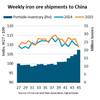BIMCO Pessimistic on Dry Bulk Market
BIMCO expects the fundamental market balance in the dry bulk shipping to deteriorate in 2019 which will do nothing to improve freight rates as the 2020 sulfur cap nears.
Earnings for Capesize vessels have continued their roller-coaster ride, reaching their highest level since the end of 2013, at USD 36,101 per day on 2 September 2019. Between 2 April, the low point of the year so far, and 2 September rates have risen 943%, into solid profit-making territory.
The strong increase in Capesize and Panamax earnings reflects a change in the market dynamics since the beginning of the year. Following major disruption at the start of the year, Brazilian iron ore exports have increased, although monthly exports since March remain lower than what they had been in the corresponding months last year. Iron ore exports bottomed out in April at 18.9 million tonnes and have since risen to 34.3 million tonnes in July.
Deliveries of 25.6m DWT compared to demolitions of only 5.5m DWT has resulted in a net fleet growth of 2.4% so far this year, with the fleet currently standing at 865.3m DWT. BIMCO expects that the dry bulk fleet will grow by 3.7% in 2019.
Year-on-year Capesize fleet growth has been below 3% since February 2019 indicating that, for the moment at least, the supply side is under control. Solid scrapping has led to 22 Capesize vessels with a cargo carrying capacity of 4.2m tonnes, leaving the fleet since the start of the year. This has only partly countered the 43 Capesizes that have been delivered, including 8 Valemax (380,000 – 400,000 DWT) and 24 VLOCs (200,000 – 350,000 DWT).
BIMCO expects that the solid scrapping activity will slow down in the second half of the year. BIMCO expects that transported volumes will grow along usual seasonal patterns in Q3 and Q4, with Capesize earnings remaining profitable for the rest of the year. This does however depend on iron ore exports from Brazil and Australia remaining stable, and Chinese demand for iron ore not falling due to the increased use of scrap steel in steel production.
Chinese coal imports, which so far this year are up 6.5%, are facing increasing domestic political influence. Reports of shipments of coal from some of the traditional coal exporters to China facing increased delays with customs clearance as well as some local customs areas limiting coal imports in 2019 to the same level as 2018, mean that this trade is an important swing factor in the rest of the year.
BIMCO expects the fundamental market balance to deteriorate in 2019 which will do nothing to improve freight rates as the 2020 sulfur cap (and its extra costs) nears. Shipowners’ ability to pass these extra costs on to shippers will depend largely on the market conditions, and for as long as supply is larger than demand, passing on extra costs will be difficult.






